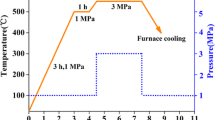Abstract
It is well known that the dynamic compressive strength of ceramics is enhanced by confining compressive stress. The paper shows how a biaxial in-plane compressive stress can be induced in a ceramic layer by encapsulation in a fiber-prestressed composite laminate. Optimal prestress distribution in individual plies of the laminate is found, together with the resulting residual stresses. Large compressive stress, 600–1000 MPa can be supported in an alumina layer by aramid/epoxy or carbon/epoxy laminates of the same total thickness as the ceramic. Stress relaxation due to either temperature changes or matrix creep is found to be of minor significance. Examples present results for specific material systems and laminate layups.
Sommario. E'ben noto che la resistenza dinamica dei materiali ceramici viene migliorata dal confinamento degli sforzi di compressione. Questo lavoro mostra come uno stato piano di compressione biassiale possa essere indotto in uno strato di materiale ceramico imprigionandolo in un laminato composito con fibre presollecitate. Viene determinata la distribuzione ottimale delle presollecitazioni nei singoli strati del laminato, nonché l'entità degli sforzi residui risultanti. Compressioni elevate, dell'ordine di 600–1000 Mpa, possono essere indotte in uno strato di allumina da laminati epossidici rinforzati con fibre aramidiche o carboniche dello stesso spessore. Il rilassamento degli sforzi dovuto a cambiamenti di temperatura o al comportamento viscoso della matrice risulta avere importanza limitata. Gli esempi forniscono risultati relativi a specifici materiali e orientamenti dei laminati.
Similar content being viewed by others
References
Arrowood, R. and Lankford, J., 'Compressive fracture processes in an alumina-glass composite', J.Materials Sci. 22(10) (1987) 3737-3744.
Ashby, M.F. and Sammis, C.G., 'The damage mechanics of brittle solids in compression', Pure Appl. Geophy. 133(3) (1990) 489-521.
Heard, H.C. and Cline, C.F., 'Mechanical behavior of polycrystalline BeO, Al2O3 and AlN at high pressures', J. Materials Sci. 15(8) (1980) 1889-1897.
Chen,W. and Ravichandran, G., 'Dynamic compressive failure of a glass ceramic under lateral confinement', J. Mech. Phy. Solids, 45(8) (1997) 1303-1328.
Lankford, J., Anderson, C.E., Jr., Nagy, A.J., Walker, J.D., Nicholls, A.E. and Page, R.A., 'Inelastic response of confined aluminium oxide under dynamic loading conditions', J. Materials Sci. 33(6) 1998 1619-1625.
Bhattacharya, K., Ortiz, M. and Ravichandran, G., 'Energy-based model of compressive splitting in heterogeneous brittle solids', J. Mech. Phy. Solids 46 (1998) 2171-2181.
Clifton, R.J., 'Response of materials under dynamic loading', Int. J. Solids Struct. 37 (2000) 105-113.
Dvorak, G.J. and Suvorov, A.P., 'Effect of fiber prestress on residual stresses and onset of damage in symmetric laminates', Composit. Sci. Technol. 60(8) (2000) 1129-1139.
Dvorak, G.J., Prochazka, P. and Srinivas, M.V., 'Design and fabrication of submerged cylindrical laminates I', Int. J. Solids Struct. 36 (1999) 3917-3943.
Srinivas, M.V., Dvorak, G.J. and Prochazka, P., 'Design and fabrication of submerged cylindrical laminates II. Effect of fiber prestress', Int. J. Solids Struct. 36 (1999) 3945-3976.
Suvorov, A.P. and Dvorak, G.J., 'Optimized fiber prestress for reduction of free edge stresses in composite laminates', (to appear in Int. J. Solids Struct., 2001).
Suvorov, A.P. and Dvorak, G.J., 'Stress relaxation in prestressed composite laminates', Submitted to J. Appl. Mech., 2001.
Ellyin, F., Hu, Y. and Xia, Z., 'Multiaxial behavior and viscoelastic constitutive modeling of epoxy polymers', Recent Trends in Constitutive Modeling of Advanced Materials, Vol. 239 (2000), pp. 13-25.
Dvorak, G.J., 'Transformation field analysis of inelastic composite materials', Proc. Royal Soc. 437 (1992) 311-327.
Maier, G., 'Shakedown theory in perfect elastoplasticity with associated and nonassociated flow-laws: a finite element, linear programming approach', Meccanica 3 (1969) 1-11.
Maier, G. and Vitiello, E., 'Bounds on plastic strains and displacements in dynamic shakedown workhardening structures', J. Appl. Mech. 41(2) (1974) 434-440.
Konig, J.A. and Maier, G., 'Shakedown analysis of elastoplastic structures: a review of recent developments', Nuclear Engng Design 66 (1981) 81-95.
Walsh, G.R., An Introduction to Linear Programming, Wiley, 1985, pp. 74-138.
Author information
Authors and Affiliations
Rights and permissions
About this article
Cite this article
Suvorov, A.P., Dvorak, G.J. Optimal Design of Prestressed Laminate/Ceramic Plate Assemblies. Meccanica 36, 87–109 (2001). https://doi.org/10.1023/A:1011909301910
Issue Date:
DOI: https://doi.org/10.1023/A:1011909301910




